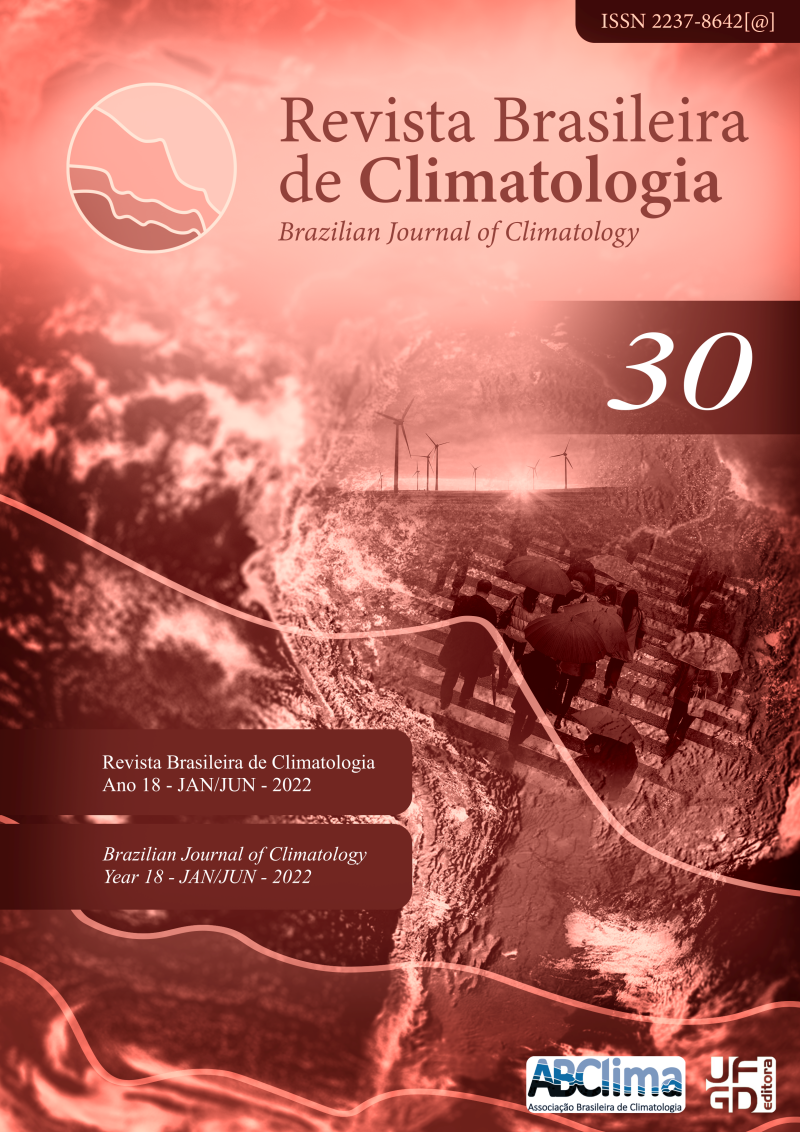Teleconnections influence on Precipitation of Brazilian Cerrado
DOI:
https://doi.org/10.55761/abclima.v30i18.14607Keywords:
Variabilidade climática. El Niño-Oscilação Sul. Dipolo do Atlântico Sul. Modo Anular Sul.Abstract
Teleconnections are remote connections, which explain the relationship between anomalies distant from each other, typically on the order of 1,000 km, covering large geographic areas. Thus, the objective of this study is to evaluate how teleconnections influence precipitation in the Brazilian Cerrado. Through seasonal linear correlation analysis (between summer 1980 and spring 2019) with precipitation (CPC/NOAA), the tropic-tropic teleconnection (SST anomalies in El Niño regions) shows that each El Niño region and season affect differently the precipitation in the Cerrado. The tropic-subtropic teleconnection (South Atlantic Dipole) shows a predominance of positive correlations in the northern Cerrado and negative (positive) correlations in the southern Cerrado, during winter and spring (summer and autumn). The tropic-extratropic teleconnection (Southern Annular Mode - SAM) shows a predominance of positive correlations in relation to negative correlations. The stochastic model suggests that about 30% of the precipitation in the Cerrado, in autumn and winter, is associated with SAM and SST anomalies in the El Niño regions.
Downloads
References
BOMBARDI, Rodrigo José; CARVALHO, Leila Maria Vespoli de; JONES, Charles; REBOITA, Michelle Simões. Precipitation over eastern South America and the South Atlantic Sea surface temperature during neutral ENSO periods. Climate Dynamics, v.42, p.1553-1568, 2014. DOI: https://doi.org/10.1007/s00382-013-1832-7 DOI: https://doi.org/10.1007/s00382-013-1832-7
CARPENEDO, Camila Bertoletti; AMBRIZZI, Tércio. Anticiclone Subtropical do Atlântico Sul associado ao Modo Anular Sul e impactos climáticos no Brasil. Revista Brasileira de Meteorologia, v.35, n.4, p.1-9, 2020. DOI: https://doi.org/10.1590/0102-77863540066 DOI: https://doi.org/10.1590/0102-77863540066
COUTINHO, Leopoldo Magno. Biomas brasileiros. São Paulo: Oficina de Textos, 2016. 160 p. ISBN 9788579752544.
GILLETT, Nathan; KELL, T.; JONES, Philip. Regional climate impacts of the Southern Annular Mode. Geophysical Research Letters, v.33, n.23, p.1-4, 2006. DOI: https://doi.org/10.1029/2006GL027721 DOI: https://doi.org/10.1029/2006GL027721
GREEN, Brian; MARSHALL, John. Coupling of Trade Winds with Ocean Circulation Damps ITCZ Shifts. Journal of Climate, v.30, n.12, p.4395-4411, 2017. DOI: https://doi.org/10.1175/JCLI-D-16-0818.1 DOI: https://doi.org/10.1175/JCLI-D-16-0818.1
GRIMM, Alice Marlene. Variabilidade interanual do clima no Brasil. In: CAVALCANTI, Iracema Fonseca de Albuquerque; FERREIRA, Nelson Jesus; JUSTI DA SILVA, Maria Gertrudes Alvarez; SILVA DIAS, Maria Assunção Faus (org.). Tempo e Clima no Brasil. 1. ed. São Paulo: Oficina de Textos, 2009. cap. 22, p.353-374. ISBN 9788586238925.
GRIMM, Alice Marlene; AMBRIZZI, Tércio. Teleconnections into South America from the Tropics and Extratropics on Interannual and Intraseasonal Timescales. In: VIMEUX, Francoise; SYLVESTRE, Florence; KHODRI, Myriam (org.). Past Climate Variability in South America and Surrounding Regions: From the Last Glacial Maximum to the Holocene. 1. ed. Dordrecht: Springer, v.14, 2009. cap. 7, p.159-191. DOI: https://doi.org/10.1007/978-90-481-2672-9 DOI: https://doi.org/10.1007/978-90-481-2672-9_7
HOLTON, James Reed. An Introduction to Dynamic Meteorology. 4. ed. Amsterdam: Elsevier, 2004. 535 p. ISBN 0123540151.
KOUSKY, Vernon; ROPELEWSKI, Chester. The tropospheric seasonally varying mean climate over the Western Hemisphere (1975-1995). NCEP/Climate Prediction Center Atlas, n.3, 1997. 135 p.
MECHOSO, Carlos Roberto; ROBERTSON, Andrew; ROPELEWSKI, Chester; GRIMM, Alice Marlene. The American Monsoon Systems: An Introduction. In: CHANG, Chih-Pei; WANG, Bin; LAU, Gabriel Ngar-Cheung (eds.). The global monsoon system: Research and Forecast. Genebra: World Meteorological Organization, 2005. Part B, cap. 13, p.197-206.
NNAMCHI, Hyacinth; LI, Jianping. Influence of the South Atlantic Ocean Dipole on West African summer precipitation. Journal of Climate, v.24, n.4, p.1184-1197, 2011. DOI: https://doi.org/10.1175/2010JCLI3668.1 DOI: https://doi.org/10.1175/2010JCLI3668.1
NNAMCHI, Hyacinth; LI, Jianping; ANYADIKE, Raymond. Does a dipole mode really exist in the South Atlantic Ocean? Journal of Geophysical Research, v.116, n.D15, 2011. DOI: https://doi.org/10.1029/2010JD015579 DOI: https://doi.org/10.1029/2010JD015579
RAO, Vadlamudi Brahmananda; CAVALCANTI, Iracema Fonseca de Albuquerque; HADA, Kioshi. Annual variation of rainfall over Brazil and water vapor characteristics over South America. Journal of Geophysical Research, v.101, n.D21, p.26539-26551, 1996. DOI: https://doi.org/10.1029/96JD01936 DOI: https://doi.org/10.1029/96JD01936
ROSSO, Flávia Venturini; BOIASKI, Nathalie Tissot; FERRAZ, Simone Erotildes Teleginski; ROBLES, Tiago Capello. Influence of the Antarctic Oscillation on the South Atlantic Convergence Zone. Atmosphere, v.9, n.11, p.1-19, 2018. DOI: https://doi.org/10.3390/atmos9110431 DOI: https://doi.org/10.3390/atmos9110431
RUDEVA, Irina; SIMMONDS, Ian. Variability and Trends of Global Atmospheric Frontal Activity and Links with Large-Scale Modes of Variability. Journal of Climate, v.28, n.8, p.3311-3330, 2015. DOI: https://doi.org/10.1175/JCLI-D-14-00458.1 DOI: https://doi.org/10.1175/JCLI-D-14-00458.1
SILVA, Viviane; KOUSKY, Vernon. The South American Monsoon System: Climatology and Variability. In: WANG, Shih-Yu; GILLIES, Robert (eds.). Modern Climatology. Londres: InTech, 2012. cap. 5, p.123-152. DOI: https://doi.org/10.5772/38565 DOI: https://doi.org/10.5772/38565
THOMPSON, David; WALLACE, John. M. Annular Modes in the Extratropical Circulation. Part I: Month-to-Month Variability. Journal of Climate, v.13, n.5, p.1000-1016, 2000. DOI: https://doi.org/10.1175/1520-0442(2000)013<1000:AMITEC>2.0.CO;2 DOI: https://doi.org/10.1175/1520-0442(2000)013<1000:AMITEC>2.0.CO;2
VASCONCELLOS, Fernanda Cerqueira; PIZZOCHERO, Renan Martins; CAVALCANTI, Iracema Fonseca de Albuquerque. Month-to-month impacts of Southern Annular Mode over South America climate. Anuário do Instituto de Geociências - UFRJ, v.41, n.1, p.783-792, 2019. DOI: https://doi.org/10.11137/2019_1_783_792 DOI: https://doi.org/10.11137/2019_1_783_792
Downloads
Published
How to Cite
Issue
Section
License
A aprovação dos artigos implica a aceitação imediata e sem ônus de que a Revista Brasileira de Climatologia terá exclusividade na primeira publicação do artigo. Os autores continuarão, não obstante, a deter os direitos autorais. Os autores autorizam também que seus artigos sejam disponibilizados em todos os indexadores aos quais a revista está vinculada.
Os autores mantém seus direitos de publicação sem restrições
A Comissão Editorial não se responsabiliza pelos conceitos ou afirmações expressos nos trabalhos publicados, que são de inteira responsabilidade dos autores.
A Revista Brasileira de Climatologia oferece acesso livre imediato ao seu conteúdo, seguindo o entendimento de que disponibilizar gratuitamente o conhecimento científico ao público proporciona maior democratização do conhecimento e tende a produzir maior impacto dos artigos publicados. Os artigos publicados na revista são disponibilizados segundo a Licença Creative Commons CC-BY-NC 4.0 (https://creativecommons.org/licenses/by-nc/4.0/). Segundo essa licença é permitido acessar, distribuir e reutilizar os artigos para fins não comerciais desde que citados os autores e a fonte. Ao submeter artigos à Revista Brasileira de Climatologia, os autores concordam em tornar seus textos legalmente disponíveis segundo essa licença




